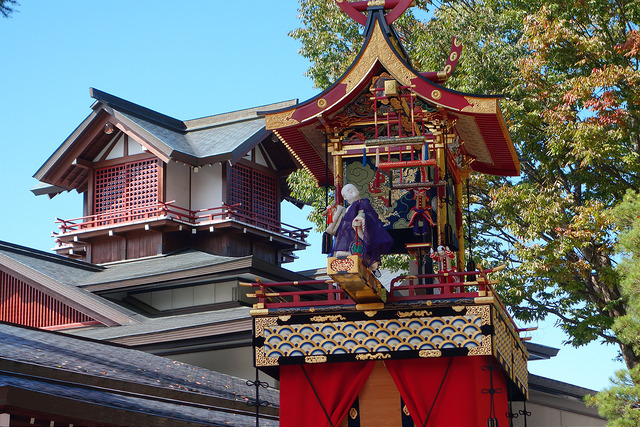Apr 01, 2020
Takayama Spring Festival
Located in Gifu Prefecture, and surrounded by some of Japan’s richest natural areas just below the famous Northern Alps, Takayama is somewhat isolated and distant. This isolation allowed the city to develop its own distinct culture that combines that of nearby Edo (modern day Tokyo) and Kyoto’s into a new and interesting way.
It also has another connection to the aforementioned Kyoto, in that it is host to one of the three most beautiful festivals in the country, the Sanno Festival
About Takayama Sanno Matsuri
The city of Takayama holds two large festivals a year, one in the spring, and the second in the following autumn. The Spring Festival, also known as Sanno Matsuri (April 14-15, 2020), focuses on the southern part of the old town known as Kamimachi, centering around the Hie Shrine which has a history going back to 1141.
With some 1,000 people taking part in the festival’s parade most dressed in kamishimo (samurai costume), the beauty of the Sanno Matsuri comes in the form of the stunning mikoshi portable shrines and ‘yatai’ floats. Dating from the early days of the festival, these floats are each etched with elaborate carvings and are decorated by the dozen local areas that they represent, and with Takayama renowned for its highly skilled carpenters and craftsmen since ancient times, these talents have been passed down through the centuries and can be found in the intricacy and charm of the floats to this day

A karakuri marionette on top of a yatai float.
Not content with being gorgeous, these yatai are also amazingly entertaining, for sitting atop each float is a karakuri puppet. Karakuri is a traditional Japanese mechanized marionette or automaton, essentially Edo-era robots.
Developed in the 17th century they are powered by a whalebone spring and controlled by a series of wheels, cams and levers, and were often used at festivals to perform reenactments of popular myths. Many of the Karakuri at Sanno Matsuri are unique to the area, and at various stages in the day will delight festival goers in turn with performances.
Following the performances, as the sun sets on the festival’s first evening, the floats are lined up and lit with ‘chochin’ lanterns. With the evening near its end, the many thousands of visitors wander the streets eating festival food, enjoying drinks, and basking in the ethereal beauty of the floats as they look forward to the coming autumn.
Sanno Matsuri Details
- Where: Hie Shrine, 156 Shiroyama, Takayama, Gifu (map)
- When: April 14 and 15, 2020.
- What’s On: Mikoshi and yatai display: 9:00 to 16:00; Karakuri performance: April 14, 11:00 and 14:30; April 15, 10:00 and 14:00; Evening festival April 14 from around 18:30 to around 21:00
About Takayama City
Even if you are unable to attend the festival (or the autumn festival on the 9h and 10th of October), you really should still make your way out to the city, as it is beautiful at any time of year.
Takayama has a very traditional feel to it, and offers a wide variety of ‘onsen’ spa hotels and guesthouses, restaurants whose dishes are distinctly local; featuring traditional regional recipes made with local ingredients. The famous beef is a must! While visiting you can see many historic buildings, or shop for local handcrafted arts.
One thing not to miss is Shirakawago, a World Heritage Site located near Takayama. Shirakawago Village is famous for traditional houses called A Gasshō-zukuri. Some of these traditional homes are hundreds of years old. This is especially impressive when you consider that the distinctive shape of the dwellings, with roofs said to resemble hands clasped in prayer, was developed to withstand the substantial weight of the heavy snow falls that all but lock in the village in winter. From Takayama, day trips to Shirakawago to see its main attraction, Ogimachi, are popular, but according to Japan Guide, the best way to experience the town is to stay overnight at one of the farmhouses, many of which now serve as minshuku, or guest houses.
Takayama is particularly famous in the spring because the cherry blossoms really enhance the gorgeous old houses and small cobbled streets. You really need to book ahead if you are planning to travel around the busy times.
If you’re wanting to stay in a Japanese guest house (anywhere, not just in Takayama), you might find this link useful: www.japaneseguesthouses.com
It takes a little more than two hours on the train from Nagoya, and about the same by car. It’s certainly a very beautiful trip as well. From Takayama, there are endless possibilities for hot springs, most featuring outdoor baths that look up into the mountains.
By Mark Guthrie and Ray Proper
Image by Jonathan Khoo (Own work) [CC BY-SA 2.0], via flickr.com (modified)
Image by Robert Young (Own work) [CC BY-SA 2.0], via flickr.com (modified)
Image by Teruhide Tomori (Own work) [CC BY-SA 2.0], via flickr.com (modified)
Image by Richard Cassan (Own work) [CC BY-SA 2.0], via flickr.com (modified)




About the author